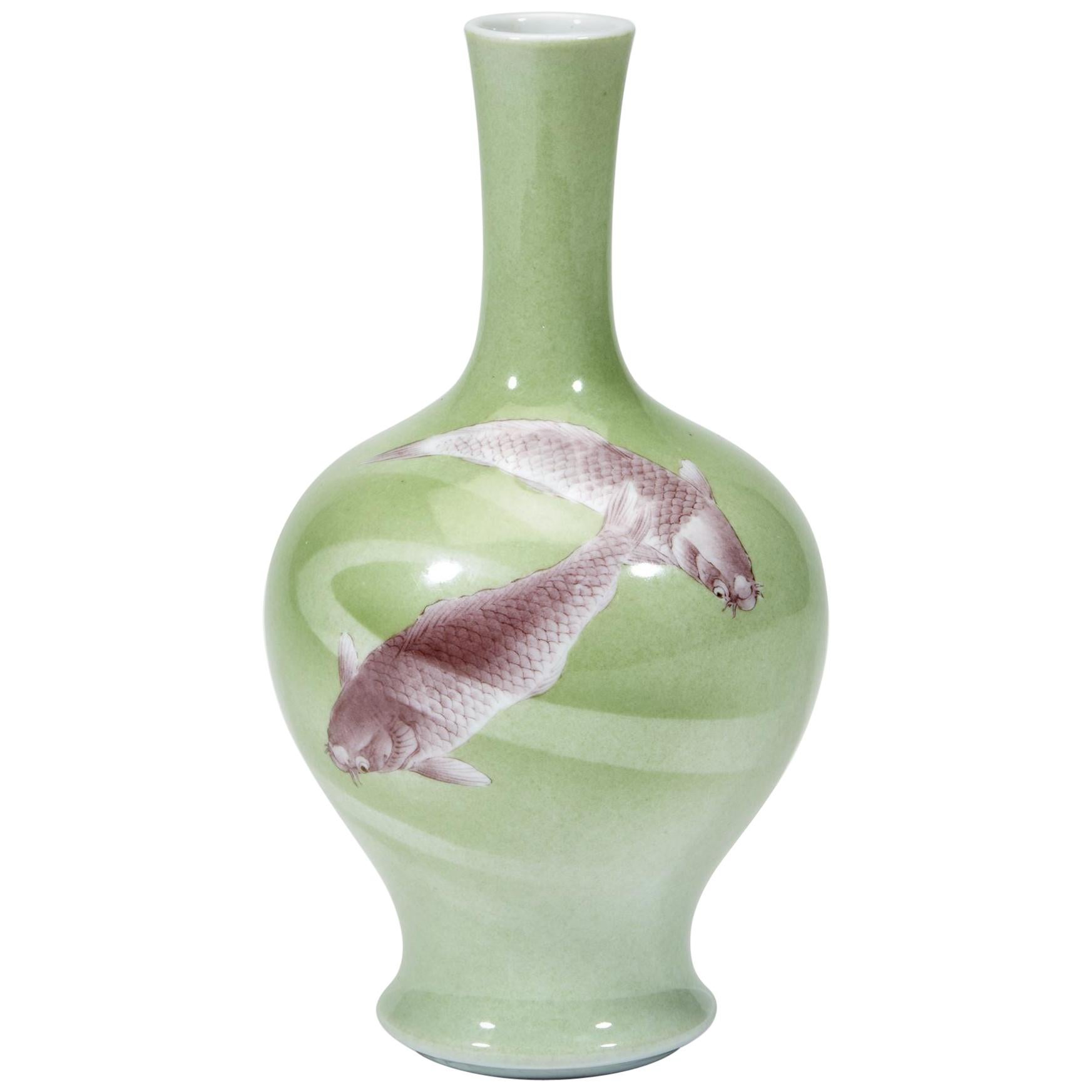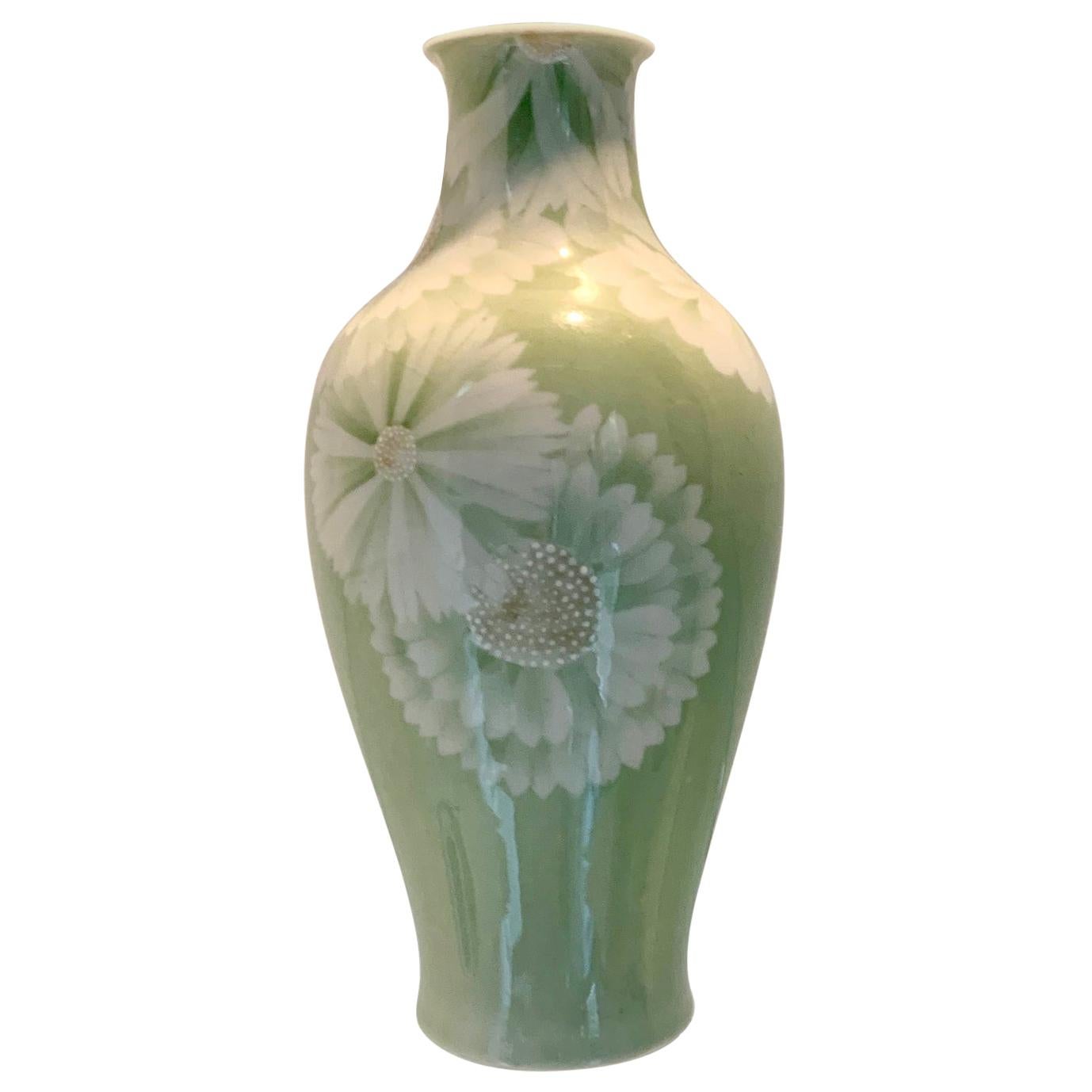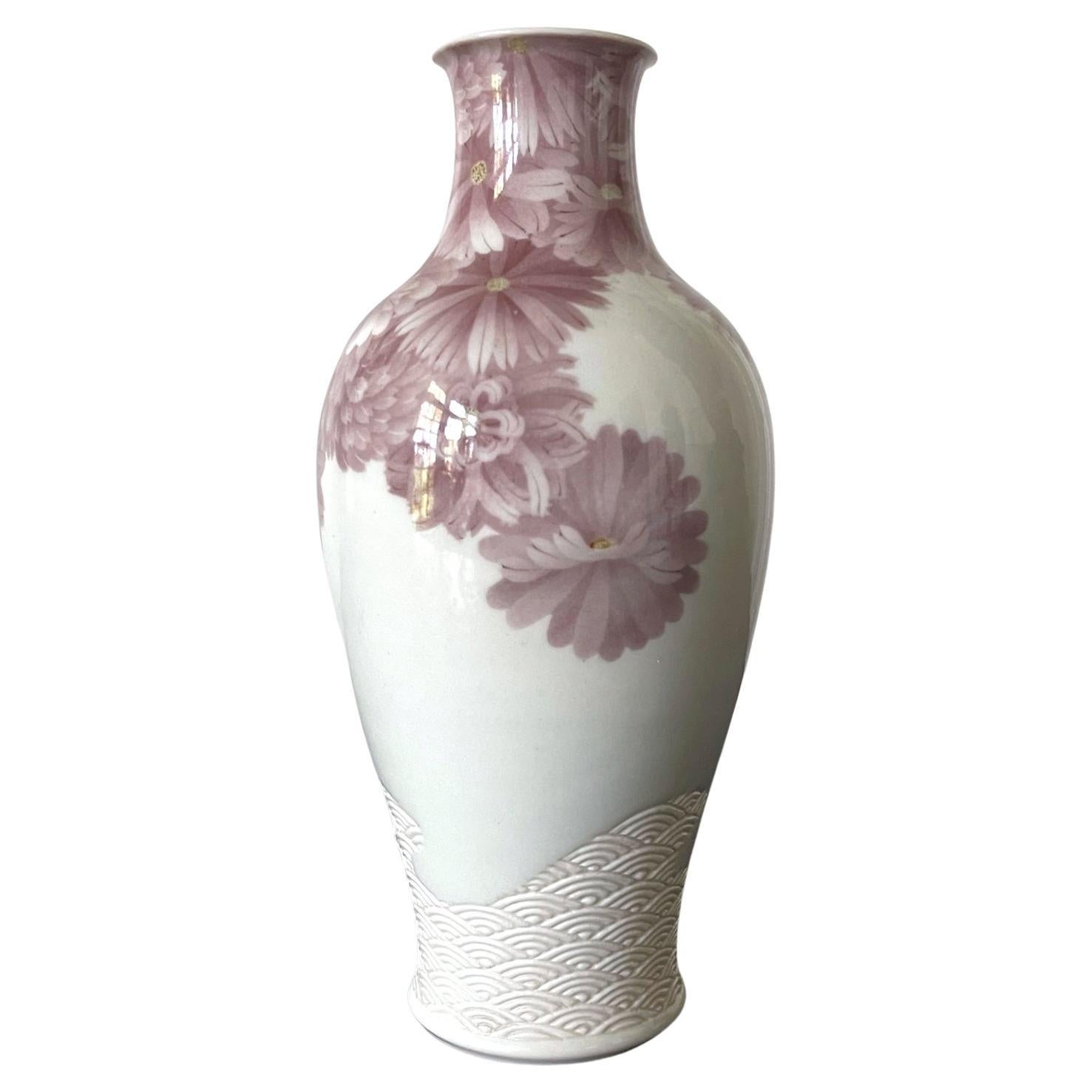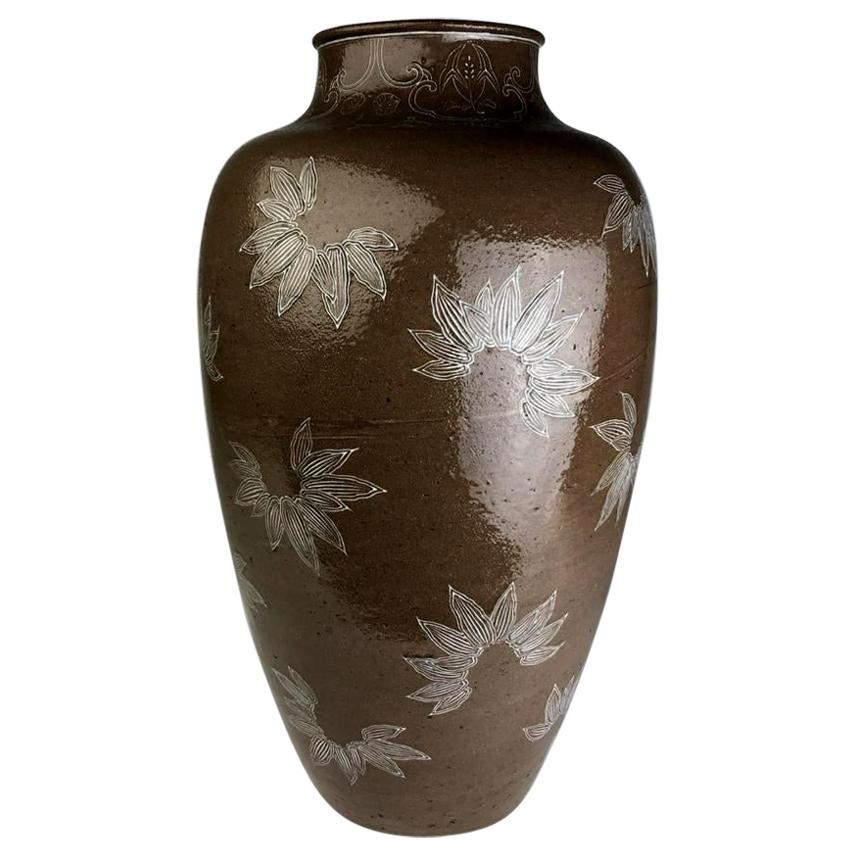Items Similar to Large Japanese Ceramic Vase by Makuzu Kozan Meiji Period
Want more images or videos?
Request additional images or videos from the seller
1 of 19
Large Japanese Ceramic Vase by Makuzu Kozan Meiji Period
About the Item
A large Japanese ceramic vase by the celebrated Meiji imperial potter Makuzu Kozan (1842-1916) circa 1880-1890s. Dated to his underglaze phase post 1887 after he successfully mastered the new colors available from the west and used them to the best advantage in his work deeply rooted in Japanese aesthetics. The vase has an impressive size and was potted in the classic baluster form with an elegant proportion. The surface is decorated using a combination of techniques of low relief sculpturing and underglaze paint to depict a copper red dragon slithering in the fish-scale waves, which was meticulously carved and covers the background of the entire vase. The five-clawed dragon nearly wrapped around and circumvent the vase. Around the short neck and the mouth, cloud patterns were created using a cobalt blue underglaze.
The vase has a striking presence: its proportion, texturized surface, the composition which leaves much negative space, and the contrast of the blue and copper red with the white carving, all come together in this piece of ceramic art. Similar creation with carved surface by Makuzu Kozan is not very common and the research indicates that they were made in the early period of his underglaze phase during his long career.
Reference: A very similar vase was recorded and dated between Meiji 23rd to 28th year (1889-1895; see last two photos).
For another jar by Makuzu Kozan decorated with entwined dragons on a stylized wave ground in the Khalili Collection, see Oliver Impey et al., The Nasser D. Khalili Collection, vol.5, Ceramics, Part I: Porcelain, London, Kibo Foundation, 1995, cat no. 12.
- Creator:Makuzu Kozan (Maker)
- Dimensions:Height: 12 in (30.48 cm)Diameter: 8 in (20.32 cm)
- Style:Meiji (Of the Period)
- Materials and Techniques:
- Place of Origin:
- Period:
- Date of Manufacture:1880s-1890s
- Condition:Wear consistent with age and use. Minor losses. Fine condition, a drilled hole through the base as shown.
- Seller Location:Atlanta, GA
- Reference Number:1stDibs: LU945033492872
About the Seller
5.0
Platinum Seller
These expertly vetted sellers are 1stDibs' most experienced sellers and are rated highest by our customers.
Established in 2006
1stDibs seller since 2010
479 sales on 1stDibs
Typical response time: <1 hour
- ShippingRetrieving quote...Ships From: Atlanta, GA
- Return PolicyA return for this item may be initiated within 2 days of delivery.
More From This SellerView All
- Fine Japanese Ceramic Vase Makuzu Kozan Meiji PeriodBy Makuzu KozanLocated in Atlanta, GAA Japanese long neck porcelain vase circa 1900-1910s by the studio of Miyagawa Kozan (1842–1916), one of the most established and collected Japanese ceramist from the end of Meiji Period. Commonly known as Makuzu Kozan, which also appears as the signature on his work, his originally birth name was Miyagawa Toranosuke. He was the appointed artist to the Japanese Imperial household and his work was exhibited in many international fairs that the Meiji government participated at the turn of the century. This vase features an elegant Classic form with a slender neck and slightly flared mouth above a baluster body. It was finely painted with two swimming carps in a copper red underglaze among green ribbons like waves. The background display a brilliant verdant green overall, Around the fish a poetic hazy effect was emphasized for a visual complexity by Fuki-e (the blow painting), an invention in Kozan's studio. The new technical development of chemical colors from the west was embraced circa 1900s in Kozan studio. This empowered the more creative experiments with not only colors, but also concept of dimension, which led Makuzu Kozan's work to become a bridge between East and West aesthetics. This is particularly evident in this vase with the Masterly details of the brush strokes, the expertly employment of gradient of color, and a very realistic and detailed rendering of the fish and their vivid motions. For two similar examples of Kozan's work with similar carps decoration, see Page 148-149 of the book: Sekai ni Aisa Reta ya Kimono Miyagawa Kozan Makuzu...Category
Early 20th Century Japanese Meiji Ceramics
MaterialsCeramic
- Japanese Porcelain Vase Meiji Period Makuzu KozanBy Makuzu KozanLocated in Atlanta, GAA finely decorated and glazed Japanese porcelain vase by Makuzu Kozan (1842-1916) circa 1900s Meiji Period. The vase is of a classic bottle form with baluster body and short neck. It was decorated with underglaze white magnolia blossom on a pleasant celadon background. The stamens of the flower were artistically rendered in a low relief, giving the design a realistic appeal with the dimension. Miyagawa Kozan...Category
Early 20th Century Japanese Meiji Ceramics
MaterialsPorcelain
- Japanese Porcelain Vase Makuzu Kozan Meiji PeriodBy Makuzu KozanLocated in Atlanta, GAA striking blue and white vase from the studio of Japanese Potter Makuzu Kozan, also known as Miyagawa Kozan (1842–1916), one of the most established and collected ceramist from Meiji Period. Born as Miyagawa Toranosuke, Kozan established his pottery studio in Yokohama circa 1870s and later became one of the appointed artists to the Japanese Imperial household. His work was exhibited in many international fairs that the Meiji government participated at the turn of the century and won many grand prizes. Of a relatively large size, this vase is decorated with underglaze cobalt blue using the novel technique developed by Kozan called Fuki-e (the blow painting). As a result, the bamboos appear took on a three-dimensional quality as if appearing in a mist. Known as one of the most creative ceramists, circa 1887, Kozan started experimenting with new chemical colors from the West in the format of his porcelain glaze. New colors allowed him to create underglaze design that appeared bright, smooth and glossy. He even invented his own receipt of cobalt blue to achieve a much brighter yet softer shade, as evident on this vase. To create landscape that is realistic and dimensional, more common in the western paintings, he was inspired by the native Japanese ink painting technique developed around 1900 by Yokoyama Taikan...Category
Antique Early 1900s Japanese Japonisme Ceramics
MaterialsCeramic
- Japanese Ceramic Vase with Delicate Carvings by Makuzu Kozan Meiji PeriodBy Makuzu KozanLocated in Atlanta, GAA delicate and rare Japanese ceramic vase by the important Meiji imperial potter Makuzu Kozan (1842-1916) circa 1887-1910. Dated to his underglaze phase post 1887 after he successful...Category
Antique 1890s Japanese Japonisme Ceramics
MaterialsCeramic
- One of The Two Japanese Ceramic Vases Makuzu Kozan Meiji PeriodBy Makuzu KozanLocated in Atlanta, GATwo small nearly identical ceramic vases by Japanese Meiji imperial potter Makuzu Kozan (1842-1916), circa 1890-1900s. The vases were made in the form of jarlet with swelled shoulder...Category
Antique Late 19th Century Japanese Japonisme Ceramics
MaterialsCeramic
- Rare Large Vase with White Slip Inlay Makuzu Kozan Meiji PeriodBy Makuzu KozanLocated in Atlanta, GAA impressively large and unusual stoneware vase in an urn shape from the studio of Japanese Potter Makuzu Kozan, also known as Miyagawa Kozan (1842–1916), one of the most established and collected ceramist from Meiji Period. Born as Miyagawa Toranosuke, Kozan established his pottery studio in Yokohama circa 1870s and later became one of the appointed artist to the Japanese Imperial household. His work was exhibited in many international fairs that the Meiji government participated at the turn of the century and won many grand prizes. This vase is dated to the end of Makuzu's life circa 1910-1916 based on similar work created around that time. After achieving domestic and international fame, Makuzu retired and handed the business to his son Hanzan in 1912. He dedicated his time to other selected projects that were more in tune with Japanese sensibility than export aesthetic. He made a group of stoneware pottery pieces inspired by Edo master like Ninsei and Kenzan as well as his own poetic creation. This piece is attributed to that period. Standing of an impressive size, this vase is more like an urn, made with stoneware instead of porcelain. It was coated with a brown iron glaze with a slight translucent quality. Underglaze whit slips were used to draw low relief decoration of bamboo leaves that sparsely scatter on the surface. Slightly more elaborate scrolling vines and autumn flowers circles under the mouth rim. Same white slip inlay was used to sign the vase under the base. The whole effect of the piece is unusual. With its dark glaze in contrast with the sparse white decoration that is more abstract and geometric than realistic, it appears almost modern with an Art Deco flavor. For stoneware urn and vase in the similar genre by Makuzu Kozan: see figure 113 on page 182 of "Sekai ni Aisa Reta ya Kimono" MIYAGAWA KOZAN MAKUZU...Category
Vintage 1910s Japanese Japonisme Ceramics
MaterialsCeramic
You May Also Like
- Large Japanese Meiji Period Imari Vase, 19th CenturyLocated in San Francisco, CAA large and impressive fine quality 19th century Imari vase, with hand painted classical floral motif and inset panels painting of playful Foo Dogs. Japan, Meiji period, late 19th c...Category
Antique Late 19th Century Japanese Meiji Ceramics
MaterialsPorcelain
- Large Meiji Period Cloisonne Enamel VaseLocated in London, GBOf ovoid form, with a narrow neck and outward flaring rim, on dark blue ground depicting wisteria blossoms in white and purple cascading from the shoulder with birds throughout and w...Category
Antique Late 19th Century Japanese Meiji Vases
MaterialsEnamel
- Large Meiji Period Satsuma Earthenware Floor VaseLocated in Lymington, HampshireA large Meiji period Satsuma earthenware floor vase, the of baluster form, painted in pastel overglaze enamels and gilding with two large sprays of flowers including prunus blossom, ...Category
Antique 1870s Japanese Meiji Ceramics
MaterialsEnamel
- Large Meiji Period Satsuma Earthenware Floor VaseLocated in Lymington, HampshireA large Meiji period Satsuma earthenware floor vase, the skittle shaped body painted in pastel overglaze enamels and gilding with a continuous frieze of the Seven Gods...Category
Antique 1870s Japanese Meiji Ceramics
MaterialsEnamel
- Satsuma Earthenware Vase, by Kinkozan, Japanese, Meiji PeriodBy SatsumaLocated in West Palm Beach, FLA Satsuma Earthenware Vase, by Kinkozan, Japanese, Meiji period (1868-1912) decorated in polychrome enamels and gilt over a clear, crackled glaze, delicately painted with ladies and men, the reverse with a flowering garden with sprays of flowers, the neck with geometric and floral designs, a band of kifu heads in silver and gilt above the foot, on a midnight-blue ground, signed Kinkozan zo...Category
Antique 1860s Vases
MaterialsEarthenware
- 19th Century Japanese Cloisonné Small Vase, Meiji PeriodLocated in Lincoln, LincolnshireThis is a very decorative small cloisonné vase, made in Japan and dating to the 19th Century, Meiji period. The vase has a good baluster shape w...Category
Antique 19th Century Japanese Meiji Ceramics
MaterialsCeramic





